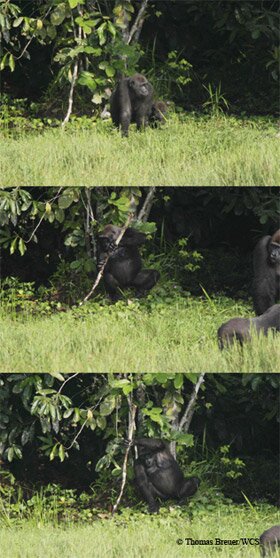Fri 30 Sep 2005

A western gorilla uses a stick to test the water for depth in the Republic of Congo. The photographs are the first documentation of gorillas using tools in the wild. (Photograph © Thomas Breuer/Wildlife Conservation Society)
John Roach for National Geographic News reports:
Researchers have observed and photographed wild gorillas using sticks and stumps to navigate a swampy forest clearing in the Republic of Congo. The images provide the first documented use of tools among wild gorillas.
In one instance, a female gorilla named Leah tried to wade across a pool of water but found herself waist deep after just a few steps. She retreated, grabbed a branch sticking out of the water, and used it to gauge the water’s depth before wading deeper.
According to the researchers, Leah repeatedly tested the depth as she walked about 33 feet (10 meters) out into the pool, before returning to shore and her wailing infant.
In another instance, a female named Efi detached a stump from a bush and used it for support as she dug for herbs. She then made a bridge with the stump to help her cross a muddy patch of ground.
“It was quite surprising to me and my team to make this observation,” said Thomas Breuer, a conservation biologist with the New York-based Wildlife Conservation Society, in an e-mail interview.
Breuer is currently in the Republic of Congo, where the observations were made at Mbeli Bai in Nouabal-Ndoki National Park.
The researchers report their observations in the October 1 issue of the journal Public Library of Science: Biology. The photographs will also be featured in the new National Geographic Television series Wild Chronicles, airing Saturday on PBS.
“This is a spectacular finding, new and astonishing, especially since gorillas have long been regarded as somehow less smart than the other great apes,” Frans de Waal, director of the Yerkes National Primate Research Center at Emory University, commented via e-mail.
Craig Stanford, an anthropologist who studies ape behavior at the University of Southern California in Los Angeles, agreed that the finding is a great surprise.
“We didn’t expect that at all,” he said. “Gorillas don’t do a lot of things other great apes do. They don’t eat meat or hunt. They lead a more sedentary life.”
Tool Use
Prior to this finding, all the other great apes had been observed using tools. Captive gorillas have been shown to use tools, but observing the behavior in wild gorillas has proven difficult.
Only a few wild gorilla groups are habituated to human presence, and those that are tend to linger where their behavior remains out of view, Breuer said. The observation of gorilla tool use came after more than 10 years of continuous monitoring at Mbeli Bai.
Though tool use is likely infrequent among gorillas, the new evidence provides insight to how gorillas see the world and interact with their environment, Breuer said.
“The most fascinating thing about this observation is the similarity [to humans] with which the gorillas solve the problems in this particular habitat,” he said. “If you or me want to cross a swamp, we use the same solutions as gorillas.”
Like humans, the gorillas in the swampy clearing jump from one dry patch to another, walk over branches, swing from trees, and—as the observations and photographs now show—use tools.
Evidence that all great ape species use tools also adds insight to human evolution, Breuer added. It suggests that tool use—once thought a distinguishing characteristic of humans—emerged in primates before humans split from the great apes.
Non-Food
Most observed instances of tool use in great apes are directly related to processing food, such as chimpanzees using sticks to fish for termites and rocks to crack nuts.
The use of sticks by gorillas for postural support suggests tool use can be triggered by other environmental factors. It also fits with the argument that tool use reflects ecological needs, Breuer and his colleagues conclude in PLoS: Biology.
Stanford, the University of Southern California anthropologist, said the tool use of gorillas is “lower order,” in the sense that their tools are not modified like the sticks chimpanzees use to fish for termites. Nevertheless, he added, the finding is “very cool.”
According to de Waal of Emory University, the observation is “a major step in our knowledge of the gorilla, who has now joined the technology crowd among our close relatives.”